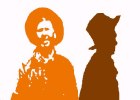Catch The Spirit of Arizona Red Rock Country home |
OH Arizona | My/Our Story | Aviation Then and Now | Airline Photos | Brief Sedona History | Movies and Movie-making | Cowboy Roundup | Wild Life | Wild Life Photos | Did you know? | Arts We Have Loved | Wedding Photos | Bird Watching | Photo Page | Monument Valley | Palatki Visit | For NATE | For NATE page 2 | Red Rock Chapbook | What's Happening?
DID YOU KNOW?
  
         |

|
|
Early Sedona settler faced many hardships and isolation.
Cowboys in Sedona area had problems finding wives, because there were few women in the region. They would go to Cottonwood, where there were school teachers. Few teachers were signed to contracts longer than 1-2 years because they were wooed and wed in very short order!!
In early 1900s the Verde Valley was wet and full of mosquitoes. Malaria was rampant and quinine was much in demand.
You might try riding a burro through the canyons, deserts and many ravines, or doing some river rafting on the Colorado River.
There are many sunny days, but watch out for cloud bursts and sudden flooded washes and low roads.
Did you know trees cover 1/5 of Arizona?
How about the fact that Arizona has the oldest rodeo in the USA? Prescott?
Did you know Arizona has more national parks than any other state?
Here are some Arizona facts
The state capital is Phoenix. It went from Prescott to Tucson to Prescott again, finally to Phoenix in 1889 (then a town of 3,000).
Arizona became a state on February 14, 1912.
The state gemstone is the turquoise.
Humphreys Peak is the highest point at 12,670 feet.
Arizona is called The Grand Canyon State.
The state bird is the Cactus Wren.
The saguaro cactus is frequently called the Monarch of the Desert in Arizona. It does not grow in the Sedona area.Too cold!
The state tree is the Paloverde.
The state flower is the saguaro blossom, a creamy white blossom, appearing in late May or early June.
The state mammal is the Ring-tailed Cat.
The area of Arizona is 113,909 square miles.
The population estimate in 1995 was 4,072,000. It has been growing since then.
Arizona has four deserts.The Great Basin, a land of deep canyons has skylines of sandstone where you see mesas, cliffs, and spires.The Mojave desert spreads across the northwestern edge of the state. It is hot and dry with fluid sand dunes.The Chihuahuan desert goes into southeastern Arizona and is mostly flat wasteland.The Sonoran desert stretches south into Mexico. Its signature plant is the saguaro, which may live 200 years and hold several tons of water. The Indians found it a most useful plant. Warning--today the plant is protected by state law. Saguaro nappers will be prosecuted. Don’t remove anything living or dead from state parks or Indian lands!That includes rocks, petrified wood, flowers, and artifacts.
Much of the preceding information obtained from UNIQUE Arizona by Tom Barr of John Muir Publications Sante Fe, New Mexico copyright 1994
Other Arizona attractions are: Slide Rock State Park, in scenic Oak Creek Canyon (Sedona area). Camping in many locations, Prescott Frontier Days, the World's Oldest Rodeo in July.
Desert images: saguaros saluting the sky, the salad bowl around Flagstaff--an important area for producing lettuce.
Try a salad in Sedona of greens grown in Flagstaff, or prickly pear cactus jams and jellies. Try some baby tumble weeds in your salad.
Try pinon nuts, acorns, mesquite tea and alcohol, beans for hair dye, cakes and flour.
Try mesquite for fuel and flavor in meats and fish. Take cholla buds for calcium.
|
||
|